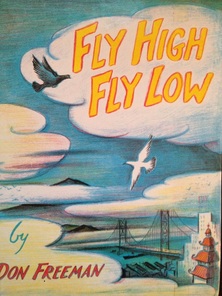
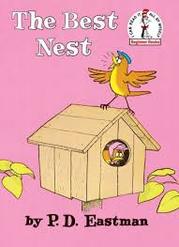
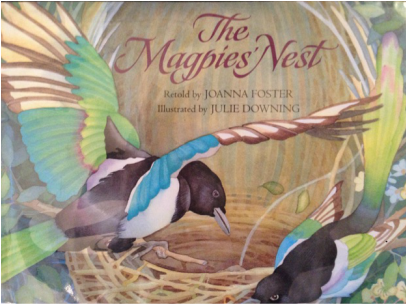
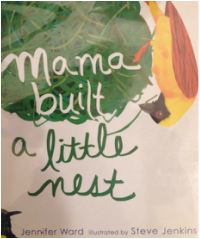
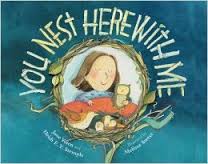
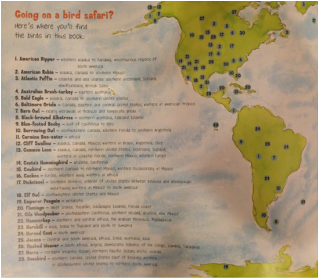
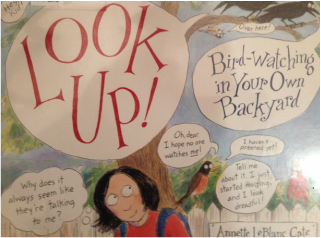
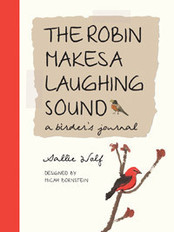
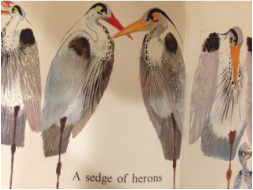
HAPPY SPRING!
|
Char Sidell is a retired elementary school librarian from Needham It’s hard to believe that it’s actually Spring as I write this! It’s been a cold, snowy and rainy April’s showers week. Hopefully, when you receive this, it will feel more like the SPRING we have been waiting for! I love this season when the world is just waking up after a long winter’s nap and everything is seemingly coming “alive” again! I love the sound of the birds returning and seeing them busy in preparation for their new families. Here, then, are some of my favorite old–and new-books on the topic. I hope you’ll find something new to use with your students and teachers!  Every year I enjoyed sharing FLY HIGH FLY LOW by Don Freeman (New York: Penguin Books, 1957) with my students. This Caldecott Honor book has all the elements that make up a Caldecott award winner, from the cover introducing the setting and the two characters, continuing over the endpapers, and on to the title page. Just introducing the story by looking at these parts of the book, students can make wonderful inferences as to what they might expect. Set in San Francisco, a pigeon has his nest in the lower loop of the letter B of the lighted BAY HOTEL sign. The other pigeons make fun of his nest’s location, but a dove stands by him sure that he has a good reason for living there. I ask students what other letters in the sign would also work for a place to live, and why or why not. Sid and Midge soon become a couple and they fly around the sights in San Francisco, getting some crumbs from Mr. Lee in Union Park Square and swooping through the Golden Gate Bridge’s arches. Sid invites Midge to share his nest with him and they are happy together until one morning when Sid is off at the park, and Midge feels their perch in the letter B moving. The sign is being taken down and moved to somewhere else in the city. When Sid comes back home, Midge is gone!  Just like in the book THE BEST NEST by P.D. Eastman (New York: Beginner Books, 1968), Sid goes on a search for Midge. He flies high and low, through fog and rain, until he is back near the park where Mr. Lee picks him up from the curb and puts him into his warm pocket. “Around the corner from here I know of a bakery where we can get something more for you to eat.” Mr. Lee notices that there’s a new letter B over the doorway of the bakery. And just like you, students have an “aahah” moment, anticipating where the letter B came from! And indeed, the cooing heard is from Midge who had stayed with the nest and its eggs now ready to hatch. Sid and Midge are reunited and they peacefully perch themselves in the lower loop of the letter B with the two new baby birds in the upper loop. Their friends coo as they fly away, ”Oh those lucky birds. Sid certainly did know what he was doing when he chose that letter B!” I love pairing this book with THE BEST NEST, which I know all of you know.  I have always been fascinated with how birds build nests using just their beaks and feet. THE MAGPIES’ NEST Retold by Joanna Foster and illustrated by Julie Downing (New York: Clarion Books, 1995), based on old English folktale, explains why each bird builds its nest in a different way. The endpapers have beautiful watercolor pictures of the nests discussed in the book as well as a pictures of the eggs and nest dimensions. The folktale begins with the birds arguing about where to put their eggs. The swans whistle that it’s a nest they need and all the birds pick up on that. The robin asks, ”What is a nest, and how do you build one?” Mother and Father Magpie announce that they can show the birds how. As the birds all gather round the magpies in the thorn tree, the whippoorwill stays nestled on the ground. “I’m so comfortable, I’m sure I can see enough from here.” Starting with mud, the magpies fly off to a nearby river and return with mud. “That’s easy enough,” says the flamingo and she flies away. Even today, flamingoes make their nests only of mud. The swallow, too, seeing how it’s done, left to get some mud, and swallows still build their nests with bits of mud. Next the magpies fly to the woods for sticks and bring them back. The eagle declares, “I’ll make a nest of stout sticks and branches.” and flies away. “Sticks and twigs, sings the little house wren…I see how it’s done.” Mother Magpie calls to the birds to “ Wait!” - there’s more they have to do. “But by this time, the flamingo and swallow, the eagle and wren were long gone.” Weaving in grasses and twigs is the next step the magpies demonstrate, but the oriole says, “So, the real secret of nest building is weaving! I’m very good at that.” And she takes off to weave her woven nest hanging down from a branch. Now most of the birds have taken off, each hearing only a part of what the magpies have said. The cuckoo and cowbird, arriving late, complain that it all looks like a lot of work. The magpies come back with thistledown, horse’s hair, moss, string and even a snake’s skin. “Moss and perhaps some spider webs might be all I really need”, says the hummingbird as she flies away. The cowbird and the cuckoo agree that they’d like to have a nest like the magpies are building, but they don’t want to do the work. They slyly decide to let the others do the work, and to this day, cowbirds and cuckoos always sneak their eggs into other birds’ nests. The magpies finish lining their nest and building a dome over top. When they look around, they realize their audience of birds has all gone, all except the whippoorwill who is content with her nest on the ground. There is an interesting Author’s Note in the back of the book explaining English Joseph Jacobs’ involvement in this tale.  There are several books one could use to follow-up the discussion of different types of bird nests. MAMA BUILT A LITTLE NEST by Jennifer Ward and illustrated by Steve Jenkins (New York: Beach Lane Books, Imprint of Simon & Shuster, 2014) would be a natural one to use. Each rhyming four-line poem describes a different type of nest but doesn’t name the bird that built it. The reader can infer what type it is from the illustrations or from the short interesting non-fiction text blocks found on the opposite page. Steve Jenkins’ colorful collage illustrations complement the text beautifully and emphasize the essential important elements that make each nest unique  Jane Yolen and Heidi E.Y. Stemple published YOU NEST HERE WITH ME (Honesdale, PA.: Boyds Mill Press) in 2015. Its simple rhyming text, beautifully illustrated by Melissa Sweet, features many types of nests. The refrain “But you nest here with me” is reassuring for younger readers who, in the end, come to know that their nest is right there at home. The Authors’ note explains the Yolen family’s interest in birds and is followed by some non-fiction fact boxes about the birds featured in the book  For somewhat older elementary students, EVEN AN OSTRICH NEEDS A NEST: WHERE BIRDS BEGIN by Irene Kelly (New York: Holiday House, 2009) would be a great book to use. The easy flowing text in lizard typeface takes the reader around the world looking at many different nests of unusual birds – the Atlantic Puffin, Australian Brush-turkey, Black-browed Albatross, Blue-footed Booby, Cuckoo, Dickcissel, Horned Coot, Ovenbird, Pileated Woodpecker, Snowy Owl, Wandering Albatross and the Yellow-rumped Thornbill, to name a few. The illustrations are done in a combination of watercolor, gouache, acrylic, and pen and ink. There is a world map in the back matter of the book asking the reader if they were interested in “Going on a Bird Safari?” “Here’s where you’ll find the forty different birds in this book.” There is also a page telling the reader “You Can Help!” neighborhood birds build their nests by gathering nesting materials and leaving they out for the birds, giving suggestions as to what kind of materials and how to make them available for the birds.  Written in a graphic novel style is Annette LeBlanc Cate’s book, LOOK UP! BIRD –WATCHING IN YOUR OWN BACKYARD (Somerville, MA.: Candlewick Press, 2011). This book is one for the classroom library to be perused and read independently. There’s a Table of Contents to help the reader through the book, leading them to such topics as “A Great Place to Start, “Shapes are Clues”, “Note the Fine Details”, “Time for a Field Guide”, “The Power of Observation”, “To You It’s Vacation; to Us It’s Migration”, and “Off You Go to Classification Class!” I really enjoyed reading this book with its conversational style and cartoon-like illustrations. It’s jam packed full of information that the reader learns easily through its entertaining presentation. You might really need more than just one copy of this book for your classroom!  THE ROBIN MAKES A LAUGHING SOUND: A BIRDER’S JOURNAL by Sally Wolf and designed by Micah Bornstein (Watertown, MA.: Charlesbridge, 2010) is a lovely book for inspiring the journaling in all of us. Wolf was influenced by her seventh-grade teacher who taught her class “to identify birds by using Roger Tory Peterson’s A Field Guide to the Birds of Eastern and Central North America.“ The class studied bird behavior through observation of the birds that frequented the bird feeders they set outside their classroom. She has been bird-watching and journaling ever since. This book is made up of Wolf’s writings, pictures, sketches, poetry, ideas, and observations from her personal journals. The back matter has information “About My Journals” and “Resources” for the reader. I enjoyed this intimate little book and it has inspired me to think of keeping a journal of my own.  It seems as though there are a few too many books in this FORUM article, but I just have to mention just one more! I found Brian Wildsmith’s BIRDS (N.Y.: Franklin Watts, 1967) on the shelf at the library, and I couldn’t leave it there. This book is absolutely magnificent! Wildsmith introduces the book with a preface entitled “A Whole Bunch of Birds”, worth reading. This book is all about collective nouns that describe different groups of birds – “A wedge of swans”, “A sedge of herons”, “A siege of bitterns”, “A watch of nightingales”, “A party of jays”, “A congregation of plover”, “A colony of penguins", and “A rafter of turkeys”. Few words but incredible illustrations! It is a feast for the eyes. As a former preschool teacher, I have always appreciated Brian Wildsmith’s beautiful books. If you do not know his work, treat yourself and find this book at the library, or any of his others. HAPPY SPRING!
0 Comments
Your comment will be posted after it is approved.
Leave a Reply. |
Forum NewsletterCo-Editors
|
|
The Massachusetts School Library Association works to ensure every school has a school library program that is fully integrated at all grade levels across the curriculum and has a significant and measurable impact on student achievement….Read more…..and Learn more about MSLA
|
Contact MSLA:
Emily Kristofek, Office Manager/Event Planner P.O. Box 336. Wayland, MA 01778 [email protected] 508-276-1697 |
